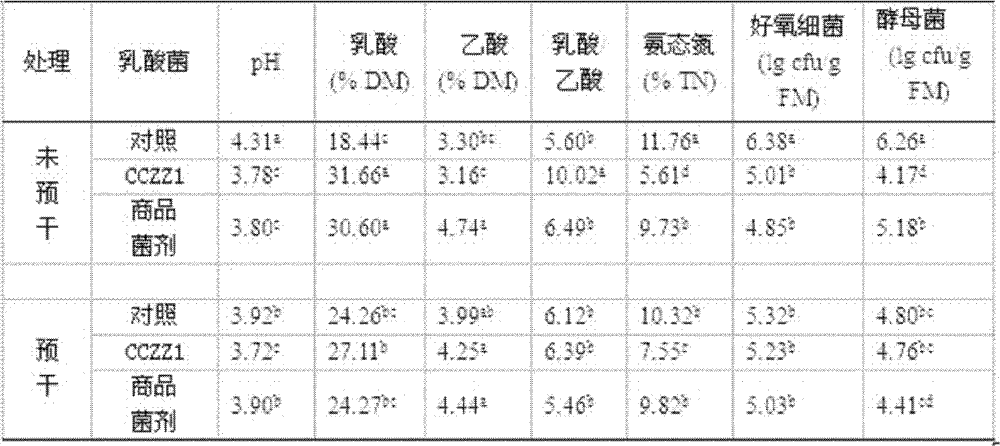Low-temperature-resistant lactobacillus strain lactobacillus plantarum CCZZ1 and application thereof
A technology of low temperature resistance and lactic acid bacteria, applied in the direction of application, bacteria, microorganisms, etc., can solve the problems of not taking into account low temperature conditions, not obvious improvement effect, unsafe operation, etc., and achieve unique effect, better effect and low cost effect
- Summary
- Abstract
- Description
- Claims
- Application Information
AI Technical Summary
Problems solved by technology
Method used
Image
Examples
Embodiment 1
[0023] Embodiment 1 screens low-temperature resistant good lactic acid bacteria
[0024] Isolate 90 strains of lactic acid bacteria from materials such as Kinggrass, Stylophyllum, corn, wild rice, etc., carry out Gram staining and cell shape observation, and according to the growth temperature (10, 15, 20, 25, 30, 35, 40, 45 , 50°C) and growth pH (3.5, 3.75, 4.0, 4.5, 5.0, 5.5, 6.0, 6.5, 7.0, 7.5, 8.0, 8.5, 9.0) and other experiments screened out low temperature resistant, acid resistant and fast growing lactic acid bacteria CCZZ1. The results showed that the CCZZ1 strain was a Gram-positive, homofermentative bacillus that could grow at 10°C and pH 3.75, had strong low temperature and acid resistance, and could ferment most sugars (Table 1).
[0025] strain CCZZ1 source corn shape Rod s + Fermentation type the same type Fertility temperature 10℃ + 15℃ ++ 45℃ + 50℃ - Fertility pH ...
Embodiment 2
[0036] Identification of embodiment 2 lactic acid bacteria
[0037] The strain was cultured overnight at 37°C in 5 mL of MRS medium, and the bacterial solution was transferred to a 1.5 mL centrifuge tube, centrifuged at 10,000 rpm / min for 3 to 5 min to collect the bacteria, and TE0.1 (10 mmol / L Tris-HCl, 0.1 mmol / L EDTA , pH 8.0) was washed twice, and then the DNA was extracted with the TIANamp Bacteria DNA Kit (TIANGEN BIOTECH CO., LTD, Beijing, China) kit, and the absorbance value was detected at OD600nm. Then, carry out PCR amplification, the amplification primers of 16S rDNA are 25f (SEQ ID NO: 1) and 1492r (SEQ ID NO: 2), RCR reaction is 95 ℃ (5min)-94 ℃ (30s)-55 ℃ ( 1min)-72°C (1.5min)-72°C (10min), 94°C (30s)-55°C (1min)-72°C (1.5min) reaction cycle 30 times. The amplified product was sent to Boshang Biotechnology Co., Ltd. (China) for sequencing, and the results were compared in the NCBI gene bank to find out the standard strains Lactobacillus plantarum IMAD 80188 (La...
Embodiment 3
[0038] Embodiment 3 is added to the effect in the silage
[0039] Silage addition experiments were carried out with lightly predried (predried refers to drying to reduce moisture content) and non-predried ryegrass as materials. Cut the ryegrass to 1cm-2cm, mix evenly, and add about 1.0×10 strain CCZZ1 per kg of fresh material 8 indivual. The ryegrass feed after adding bacterial strain CCZZ1 is packed into the polyethylene silage bag of 30cm * 20cm, and each processing packs 3 bags, and every bag is about 200g, with vacuum sealer (SINBO Vacuum Sealer, Hong Tai Home Electrical Appliance Co.Ltd.) Evacuate, seal, and store at 15°C for 30 days.
[0040] The rice is cut to 1-2 cm, mixed evenly, and about 1.0×108 strain CCZZ1 is added per kg of fresh material. The rice feed added with the strain CCZZ1 was put into 30cm×20cm polyethylene silage bags, 3 bags for each treatment, each bag was about 200g, pumped and sealed with a vacuum sealing machine, and stored at room temperature (...
PUM
 Login to View More
Login to View More Abstract
Description
Claims
Application Information
 Login to View More
Login to View More - R&D
- Intellectual Property
- Life Sciences
- Materials
- Tech Scout
- Unparalleled Data Quality
- Higher Quality Content
- 60% Fewer Hallucinations
Browse by: Latest US Patents, China's latest patents, Technical Efficacy Thesaurus, Application Domain, Technology Topic, Popular Technical Reports.
© 2025 PatSnap. All rights reserved.Legal|Privacy policy|Modern Slavery Act Transparency Statement|Sitemap|About US| Contact US: help@patsnap.com


